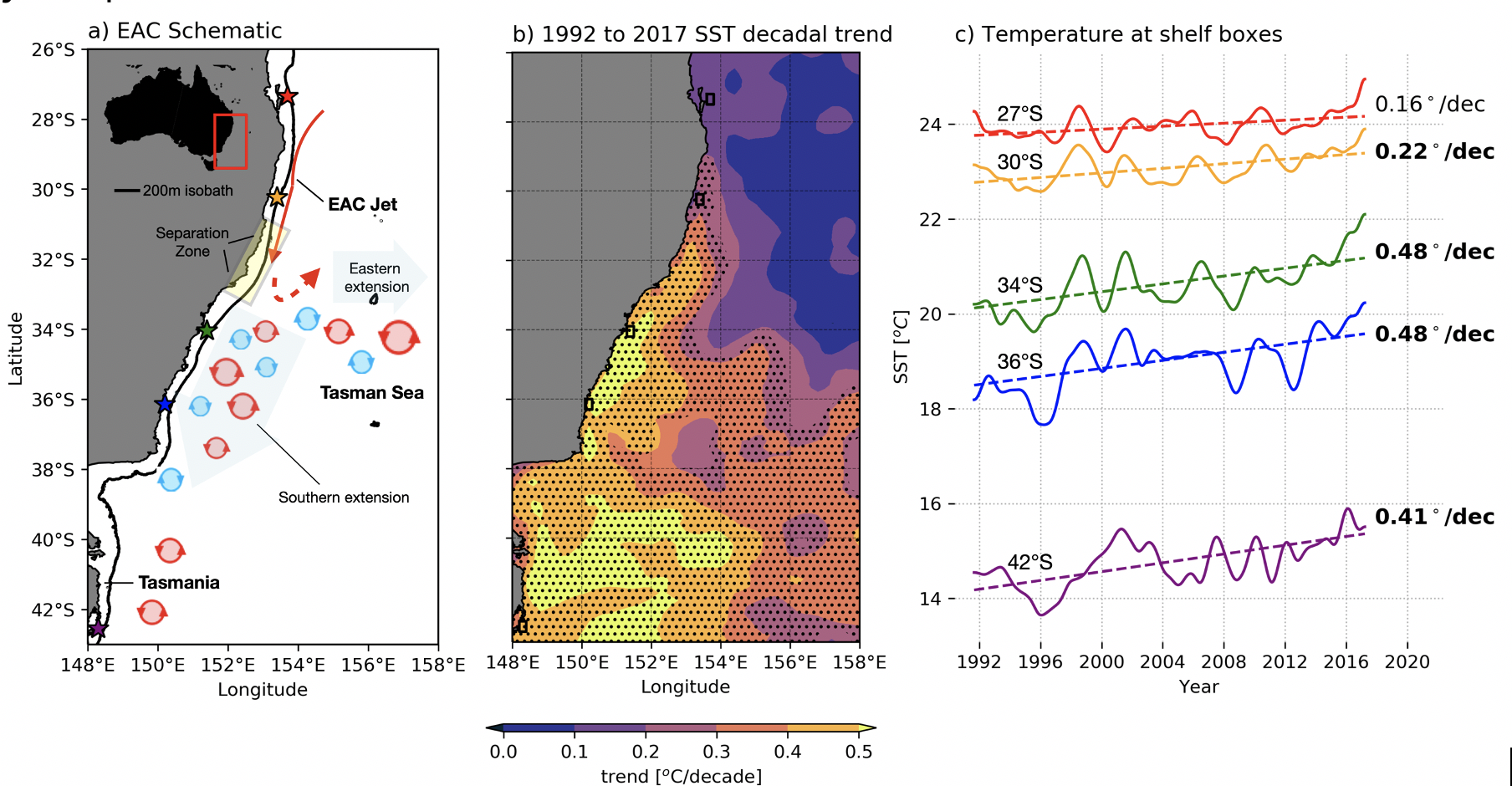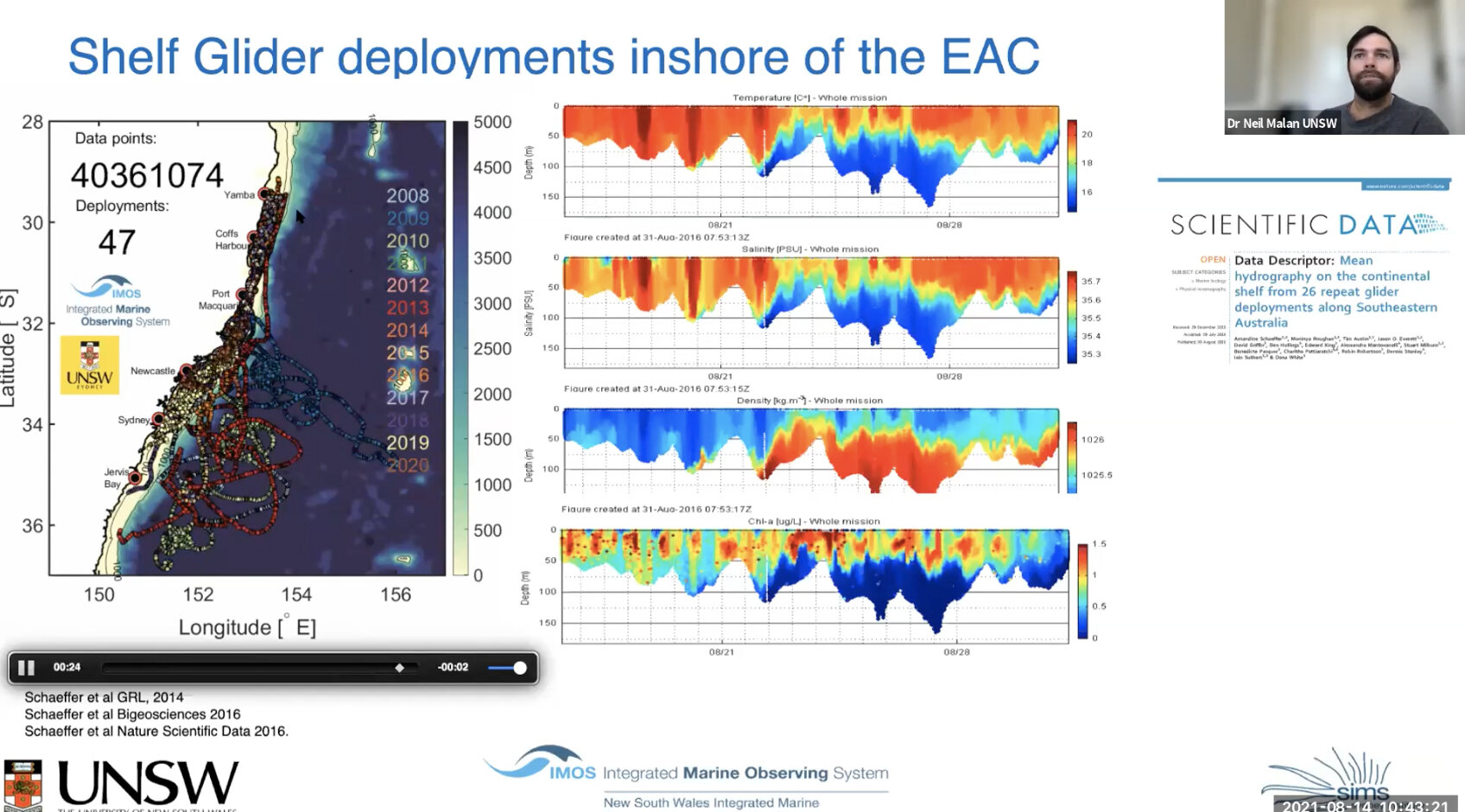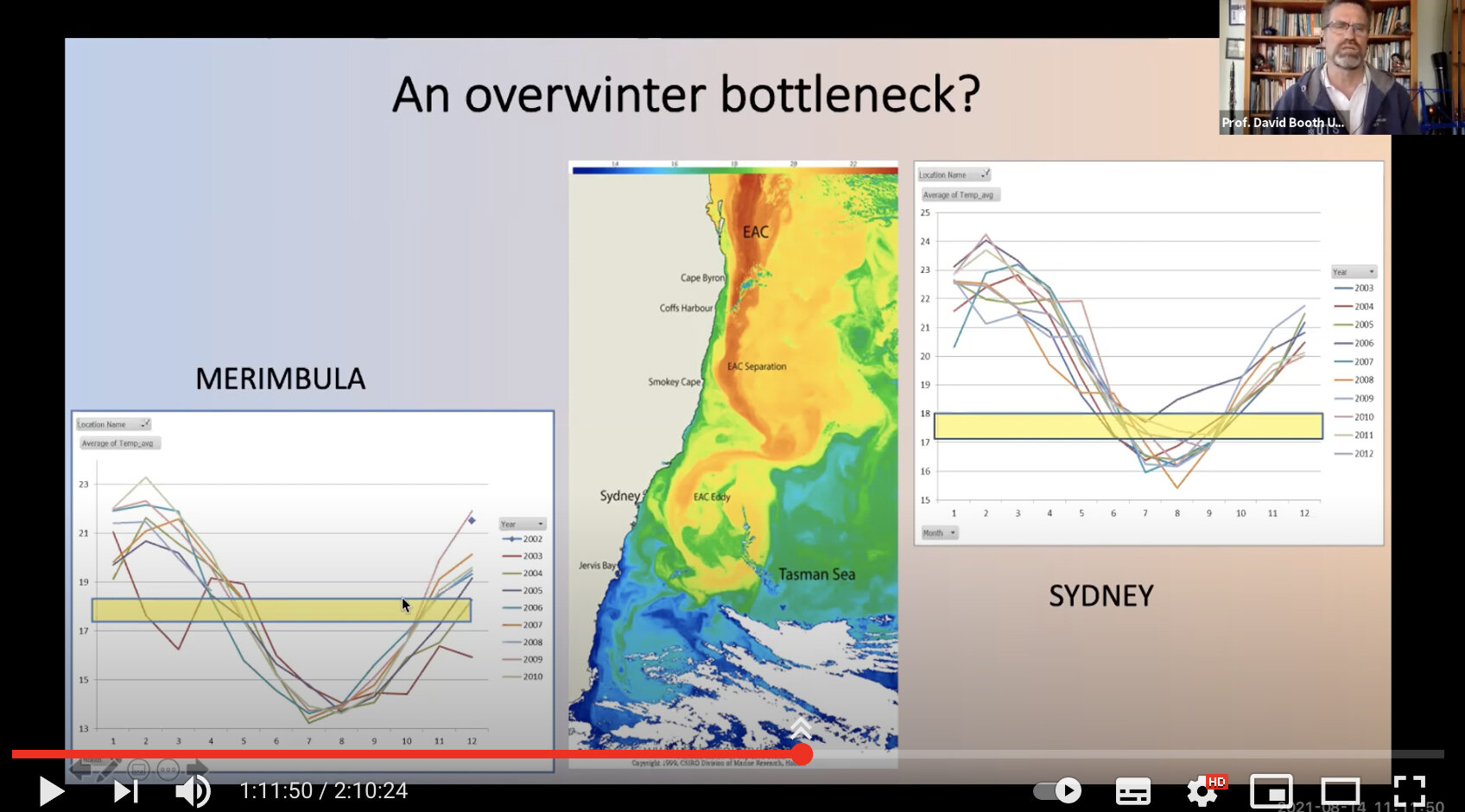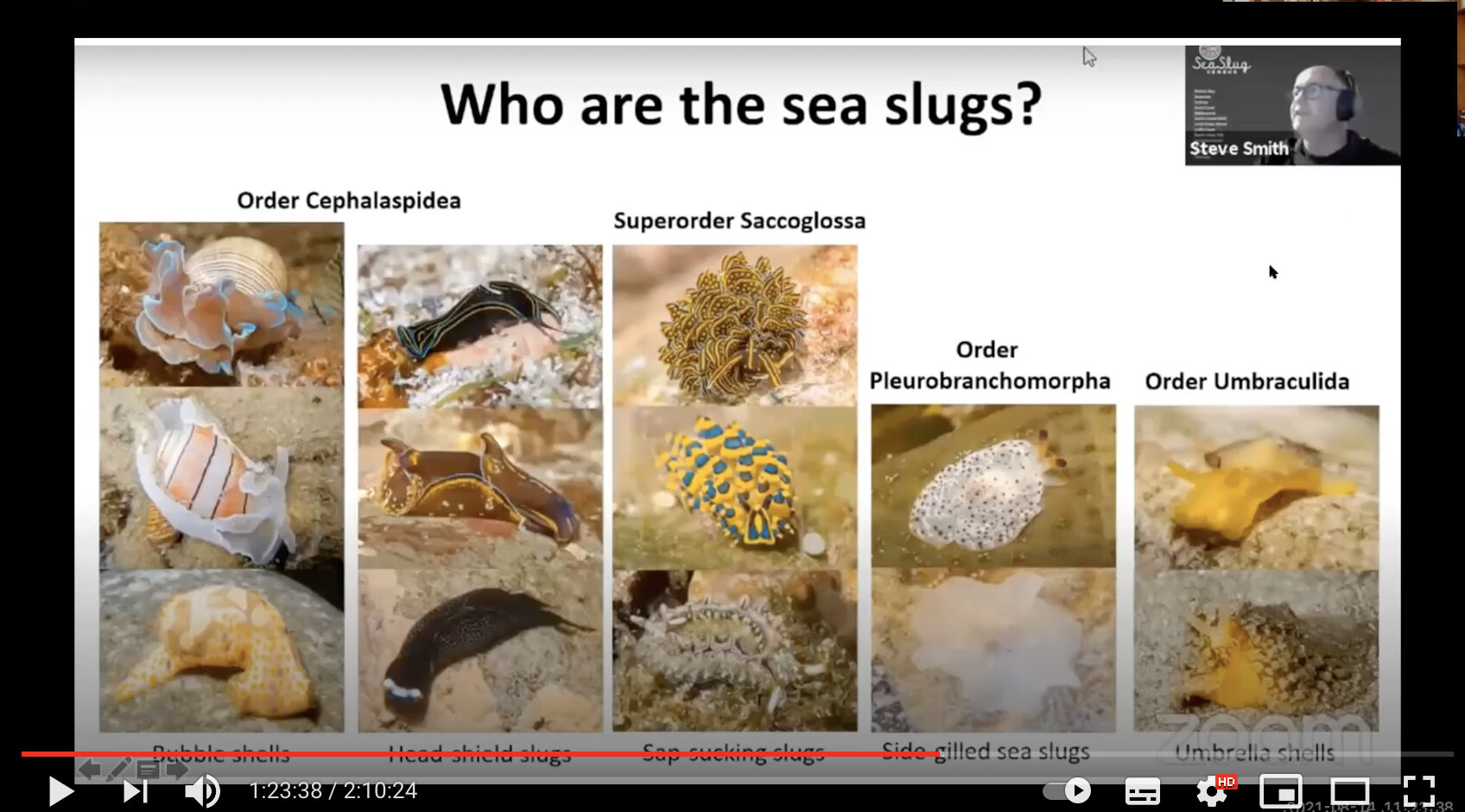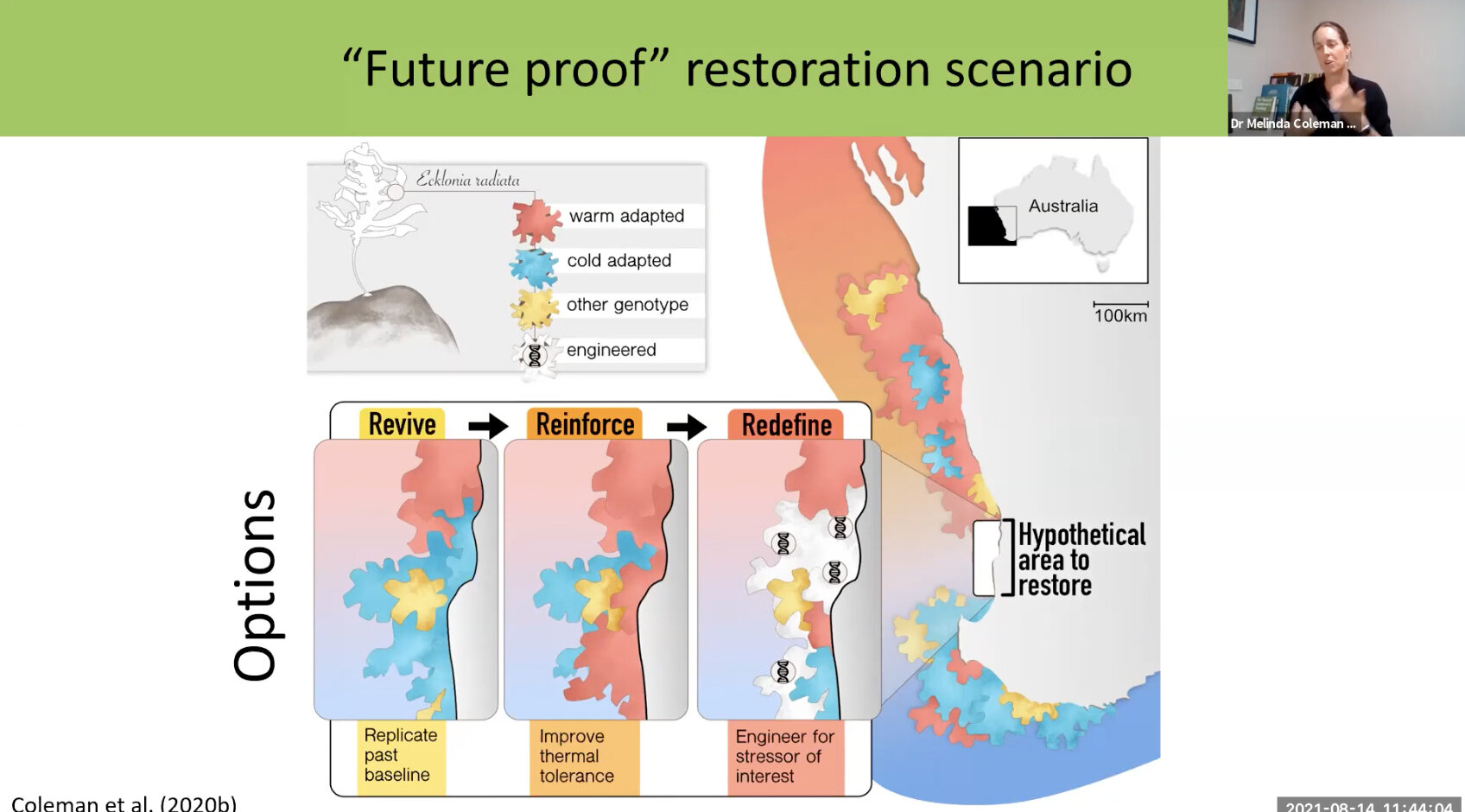August 14th 10 am – 12:30 PM
Sapphire Coast Symposium – Our East Australian Ocean hotspot – what is it and how is it and will it change our coastal ecology
Presentations and presenters:
The Gulf Stream and the abundance of oceanic eddies (circular flow features) in the North Atlantic. [Visualization using output from the MIT/JPO project]
Screenshots from Navid’s presentation
The ocean currents in a changing climate
Dr Navid Constantinou10:00 am Presentation – Dr Navid Constantinou - An overview of the ocean’s major circulation features. Touch upon what shapes these oceanic flow patterns and how have they been evolving in a changing climate. I joined ANU as part of the ARC Centre of Excellence for Climate Extremes in May 2018
Presenter - Navid grew up in Cyprus, studied in Greece (both undergraduate and Ph.D. 2015), worked as a researcher in California (2015-2018) and then landed down under at the Australian National University. He’s a physicist and he’s fascinated with geophysical fluid dynamics. His research spans across themes like the subpolar jet streams in the atmosphere, the stripy patterns on Jupiter, and the ocean’s circulation. Nowadays he calls himself an oceanographer. He recently received a Discovery Early Career Researcher Award (DECRA) from the Australian Research Council to work on using artificial intelligence (machine learning) to improve climate models.
Besides research he finds joy in surfing, dancing, horse riding, and bicycling.
Website: www.navidconstantinou.com
Email: navid.constantinou@anu.edu.au
A recent article of Navid’s from the Conversation
View Navid’s presentation at 07:15 in the following video: https://www.youtube.com/watch?v=Xib_t66Mqt8
Screenshots from Neil’s presentation
Jack Hannan photos
Kack Hannan photo
Jack Hannan photo
Screenshots from David’s presentation
A selection of nudibranchs from our 2018 Sea Slug Census
Screenshots from Steve’s presentation
Dr Melinda Coleman
Surveying kelp forests
Screenshots from Melinda’s presentation
Coastal ocean warming along southern NSW – insights from a decade of in-situ, and 25 years of satellite observations Dr Neil Manan
10:25 am Presentation – Dr Neil Malan - Over the last 25 years, the fastest warming area of the coastal ocean on the east coast of Australia has been the NSW south coast, between Sydney and Narooma. We can track this warming using observations from in-situ oceanographic moorings maintained by Australia’s Integrated Marine Observing System, as well as observations from satellites. They reveal that the south coast has been warming at a rate of 0.48 per decade between 1992 and 2017, approximately four times the global average, with the warming appearing to accelerate recently. This warming is driven by changes in the nature of the East Australian Current and its southern eddy field, resulting in a non-uniform pattern of ocean temperature increase along the east coast. Warming is occurring at a slower rate further north, with Coffs Harbour warming at 0.16 per decade, which is more in line with the global average.
Presenter - Dr Neil Malan
Neil is a post-doctoral research associate working with Prof. Moninya Roughan in the Coastal and Regional Oceanography Lab, at UNSW Sydney. He focuses on using various combinations of ocean observations and modelling to study western boundary current dynamics, and particularly how they scale down to impact the continental shelf. He completed his PhD at the University of Cape Town, South Africa on the impact of the Agulhas Current on shelf circulation and has also worked on tropical cyclones and subsurface intensified eddies in the Indian Ocean. His current interest is in the temperature dynamics and shelf-deep ocean exchange processes in the East Australian Current System. Coastal and Regional Oceanography Lab, School of Mathematics and Statistics, UNSW, Sydney, n.malan@unsw.edu.au
Watch Neil’s presentation at 36:25 at the following link: https://www.youtube.com/watch?v=Xib_t66Mqt8
NEMO AND THE DRAGON - THE SAPPHIRE COAST A TRANSITION ZONE
Prof. David Booth10:50 am Presentation – Prof. David Booth - Nemo and the dragon: is the Sapphire coast a transition zone for tropical expatriates and sea dragons?
For the last two decades, we have monitored populations of coral reef fishes and the weedy seadragon (Phyllopteryx taeniolatus) in SE Australia, today I will discuss evidence of range shifts linked to climate change.
Over 100 coral-reef fish species disperse poleward from the Great Barrier Reef, and a 20-year dataset reveals that while most taxa have increased over this time, some have declined. Based on inter- and intra-annual patterns of settlement and disappearance of each species, and supplementary experimental data, we estimate the likelihood of establishment of coral-reef “vagrants” on Sapphire Coast reefs. Key external variables include seasonal water temperature (source and sink), patters of East Australian Current strength, and aspects of the local temperate receiving environment.
Weedy seadragons (Fam. Syngnathidae) in contrast are temperate fishes with likely poleward contraction of their geographic range as a consequence of climate-change related kelp loss. I will describe the life history of this species, as well as evidence for declines across their range, and high spatial structure across SE Australia including the Sapphire coast region, and possible poleward shift in their northern range limits.
Presenter - Prof David Booth UTS
David Booth is a highly-cited marine researcher whose work over many years has heightened awareness of the impact of anthropogenic forces, such as pollution and climate change, on fisheries.
A Professor of Marine Ecology in the School of Life Sciences at UTS, David has published more than 180 papers about reef-fish ecology, climate change and other anthropogenic impacts on fishes and fisheries, in the Caribbean, Hawaii, and the Great Barrier Reef. He has spent nearly two decades monitoring the migration of tropical fish down the East Australian Current, past Sydney and Luke Brown and Atlas of Life, have contributed our records of tropical fishes in our region. He leads UTS’s research of weedy seadragons, an endemic species of Australian syngnathid that ranges from Port Stephens, NSW to Geraldton in Western Australia, and he is the International Union for Conservation of Nature’s (IUCN) specialist on seadragons. David is a strong advocate of sustainable fisheries and marine parks, and a supporter of citizen science.
Watch David’s presentation at 1:00:00 here: https://www.youtube.com/watch?v=Xib_t66Mqt8
SEA SLUGS AND RANGE CHANGES ON THE EAST COAST OF AUSTRALIA
Prof Steve Smith11:15 am Presentation - Sea Slugs, ocean warming and changes in range and distribution on the East coast of Australia.
The south eastern Australian coast is a recognised climate change hot spot and, as a result, poleward shifts in distribution are expected for many taxa. The Sea Slug Censuses organised by SCU and that the Atlas of Life has held over the last 4 years, have produced results that have demonstrated changes……
There is increasing evidence of poleward migration of a broad range of taxa under the influence of a warming ocean. However, patchy research effort, the lack of pre-existing baseline data, and taxonomic uncertainty for some taxa means that unambiguous interpretation of observations is often difficult.
Sea slugs provide a useful target group for monitoring shifts in distribution. As many sea slugs are highly colourful, popular with underwater photographers and rock-pool ramblers, and found in accessible habitats, they provide an ideal target for citizen scientist programs, such as the Sea Slug Census. This maximises our ability to rapidly gain usable diversity and distributional data. Here, we review records of recent range extensions by tropical species into the subtropical and temperate waters of eastern Australia and document, for the first time in Australian waters, observations of three tropical species of sea slug as well as range extensions for a further six to various locations in the Tasman Sea.
Presenter – Prof Steve Smith SCU and Libby Hepburn
Watch highlights from Steve’s presentation at 1:22:56 here: https://www.youtube.com/watch?v=Xib_t66Mqt8
FUTURE-PROOFING OUR KELP FORESTS
Dr Melinda Coleman11: 40 am Presentation - Dr Melinda Coleman - Kelp forests adaptation & climate change
Climate change is causing widespread habitat deterioration and destruction and presents one of the biggest threats to species and global ecological function. Underwater kelp forests underpin fisheries and vast economic values on temperate coasts but are declining due to climate change. There is an urgent need to develop novel and proactive solutions to combat, reverse and prevent this habitat loss. I will discuss the impacts of climate change on kelp in NSW and solutions to “future-proof” these forests under climate change.
Presenter – Dr Melinda Coleman is a Principal Research Scientist with NSW Fisheries and Adjunct Professor at Southern Cross University and the University of Western Australia. She has previously been an Australian Research Council Fellow and a postdoctoral fellow at the University of Maine, USA. Melinda leads a team of postdocs and students across government and university sectors to inform proactive marine management that anticipates and prepares for climate change. By melding ecology with genomics her team is providing new solutions for conserving and managing kelp forests in a future of increasing change. As a founding member of the Green Gravel action group and the award-winning Operation Crayweed team, Melinda is actively restoring lost kelp forests around Australia with the aim of boosting resilience to future climate change.
Watch Melinda’s presentation from 1:28:24 here: https://www.youtube.com/watch?v=Xib_t66Mqt8
12:05 PANEL DISCUSSION - Q&A AND OUR COASTAL ECOSYSTEMS IN 10 YEAR’S TIME
Watch the panel discussion at 1:52:38 here: https://www.youtube.com/watch?v=Xib_t66Mqt8
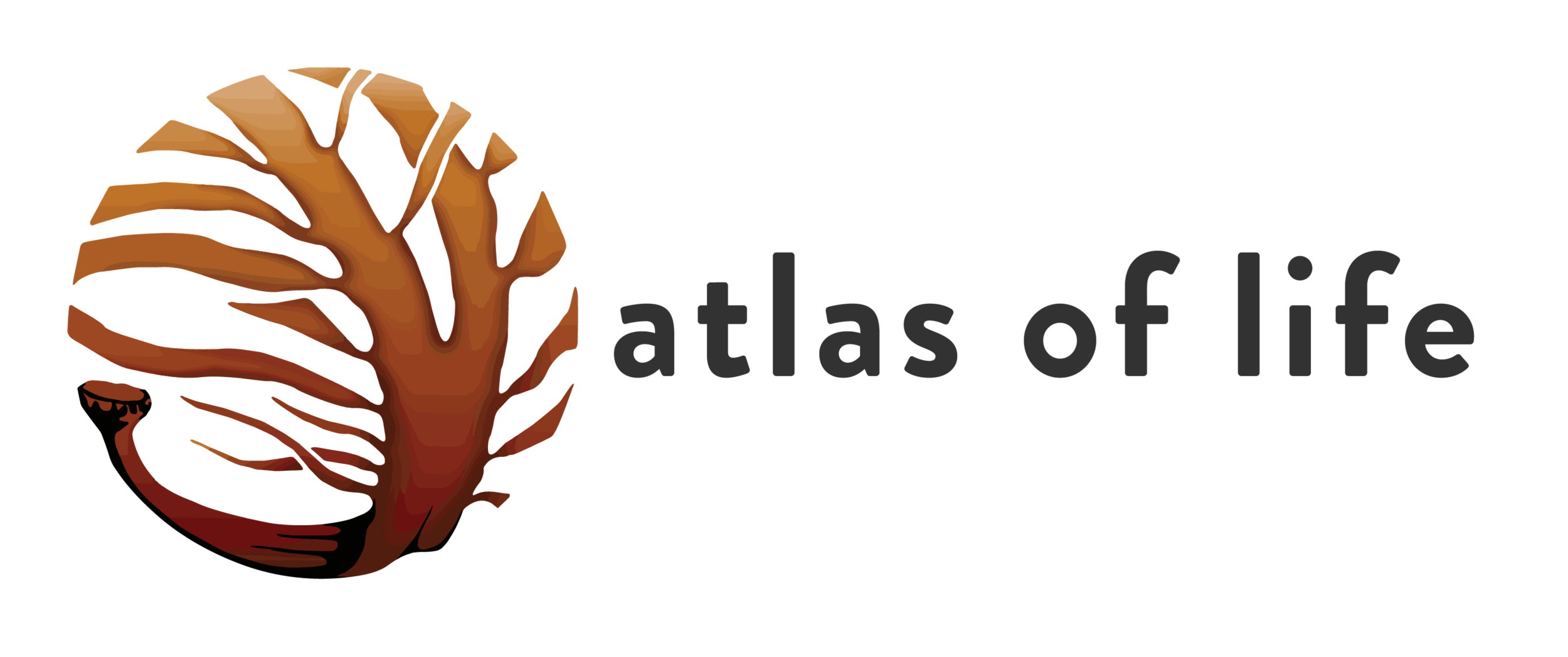
![The Gulf Stream and the abundance of oceanic eddies (circular flow features) in the North Atlantic. [Visualization using output from the MIT/JPO project]](https://images.squarespace-cdn.com/content/v1/5a8c962e0abd041f2894bebd/1628058393603-O7CM4C6Y6G94VWYA3NC3/Screen+Shot+2021-08-04+at+4.25.56+pm.png)



